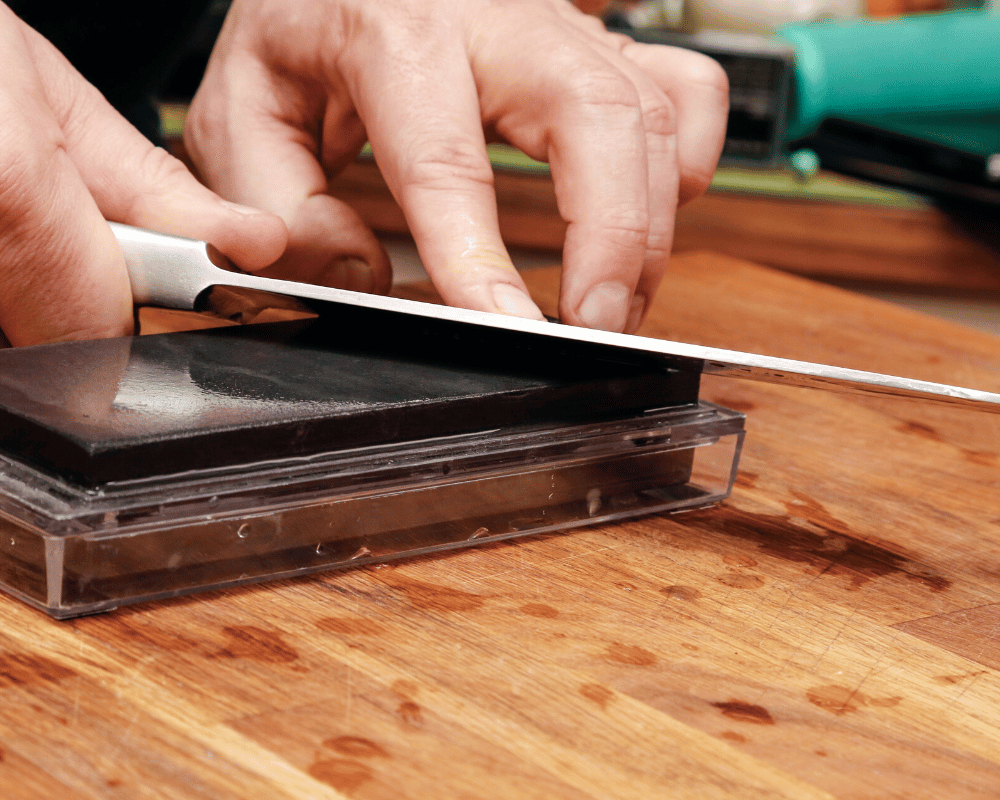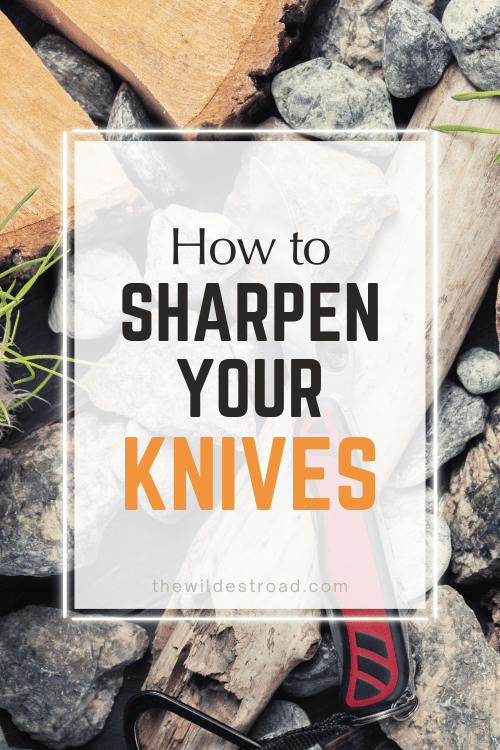Knife Sharpening 101: How to Sharpen Your Knives
A well sharpened knife is an essential tool for the outdoors, as well as for everyday activities.
Whether you’re hiking through the mountains and forests, or simply need a good blade to cut up some cartons and rope, a well maintained knife should always have a place in your kit.
But how do you make sure your knife is always in top condition?
Sharpening and maintaining a blade is a skill that we all should have, and yet the information on how to do it is often muddled and contradictory.
To help you, we’ve created this guide to lead you through all the tips and tricks you’ll need to make sure your knife is always ready to use.
So, grab your knife and notebook and let’s get started!
What does it mean to sharpen your knife?
In order to learn how to sharpen a knife, you first need to understand what it is that makes a knife sharp or dull in the first place.
Simply put, a knife is sharp because of microscopic serrations, or teeth if you will, that line the edge of the blade. These serrations are much too small for the human eye to see, and act exactly the same way as a saw or a bread knife, just on a much, much smaller scale.
The finer and alined the serrations, the sharper the knife.
Now, when these tiny teeth get bent out of shape or break, the knife starts losing its edge and becomes dull. This can happen quickly or slowly depending on the material that is being cut, how often the knife is used and the quality of the steel.
Edge maintenance is done by either removing material from the blade to create a new edge, or by re-straightening the existing one.
Why is it important for your knife to be sharp?
Now that we’ve established what it is that makes a knife sharp in the first place, why should you bother maintaining your knife?
Simple, a dull knife is more dangerous than a sharp one.
While that sounds absurd, it is absolutely true!
The reason is that a dull knife requires a lot more pressure and energy behind it to slice through material, and that pressure can easily cause the blade to slip out of control, greatly increasing the risk of injury. A sharp blade will slice more gently through the material, giving you much more control and stability.
Of course, remember that an injury caused by a sharp blade has the potential of being more serious, but the risk of an accident is reduced. ⠀⠀⠀⠀⠀⠀⠀⠀⠀⠀⠀⠀
⠀⠀⠀⠀⠀⠀⠀⠀⠀⠀⠀⠀ ⠀⠀⠀⠀⠀⠀⠀⠀⠀⠀⠀⠀
Sharpening or honing?
We mentioned before that maintaining a knife is done by either removing material from the edge to create a new one, or by straightening the existing one. That is the essential difference between sharpening a honing.
Both are essential to keeping your edge in top condition. But how do you know which one your knife needs?
Sharpening:
Sharpening your knife is done by pushing the blade against a rough and abrasive surface, such as stone and leather, in order to remove a damaged edge and create a new one. This process removes a small quantity of steel from your knife every time, so it should be done only when necessary, and when honing no longer works.
Honing:
Contrary to sharpening, honing your knife does not remove any material from the blade. Rather, the serrations that form the edge are pushed back in place and straightened, restoring the knife’s cutting power. This is usually done with a steel honing rod, or less commonly a leather belt. The only issue with honing is that these microscopic teeth will eventually start rounding and folding, and will be impossible to straighten. When this happens, the knife will need to be sharpened.
How do you sharpen your knife?
A knife can be sharpened using a variety of tools and materials. The most common and easiest to use tool to maintain your knife is a sharpening stone.
Sharpening stones come in different levels of roughness, or grain. The grain of the stone determines the level of sharpness you will achieve.
The higher the number, the finer the grain and the sharper the result:
⠀⠀⠀⠀⠀⠀⠀⠀⠀⠀⠀⠀Grain 200 to 600: Good to restore the edge of blunt knives.
Grain 800 to 1000: Best to sharpen knives that still have a good edge.
Grain 2000 to 3000: To bring knives to stock level sharpness or higher.
Grain 5000 to 12000: To make the blade razor-sharp.
⠀⠀⠀⠀⠀⠀⠀⠀⠀⠀⠀⠀To use a sharpening stone, lay it first on a flat surface, then set the blade against the stone at about a 20°-25° angle. Gently and slowly push the knife away from you against the length of the stone, without applying too much pressure.
Try to keep the angle consistent, and take breaks to inspect your results. Also, remember to flip the knife over to sharpen it evenly on both sides!
How do you hone your knife?
Honing a knife is a little easier than sharpening it, and requires less practice. For this you’ll need a honing rod.
To use a honing rod, hold it steady in one hand and pass the edge of the knife against it, almost as if you were trying to cut thin slices off it. As with sharpening stones, go slowly and gently, as precision and consistency are much more important than speed.
A good tip is to use a rod that is slightly longer than the length of your knife, as you’ll have a much easier time passing the blade against it than with a smaller one.
Is carbon steel sharpened the same way as stainless steel?
The type of steel used to create the blade of your knife will definitely have an impact on the way it is sharpened.
While the techniques used remain the same, the main difference you’ll notice is that stainless steel requires significantly more time and effort to sharpen. Not only, a carbon steel knife will usually become sharper, as well as hold an edge for longer. Therefore, if you’re looking to practice your sharpening skills, it’s a good idea to buy a cheap carbon steel knife.
⠀⠀⠀⠀⠀⠀⠀⠀⠀⠀⠀⠀Is it possible to over sharpen a blade?
While sharpening a knife is a good practice to have, it is indeed possible to over do it. You have to remember that sharpening removes material from the blade, so by doing it too much you’re actually stripping away that great new edge you just spent so much time and effort to create.
Hone your blade when necessary, and resort to sharpening only when necessary.
For most people that use their knives on a regular basis, a good sharpening is only needed once or twice every few months.
⠀⠀⠀⠀⠀⠀⠀⠀⠀⠀⠀⠀A good way to test if your knife is at a proper sharpness level is to slice a piece of paper. Simply hold the paper in one hand, then slowly pass the blade from one corner to the other. A well sharpened knife should slice through the paper with no effort.
What is a good sharpening beginner’s kit?
Having a proper sharpening kit is a must for all knife enthusiasts. When you get more handy and confident, you can start adding items such as a strop, belt sanders and dremels, but to get started all you need is a sharpening stone set and a honing rod.
A good set to get you going is the King 1k/6k.
While not the most high-end stone on the market, you’ll be able to get your hands on it for less than 50$ (a fairly decent price, as far as sharpening stones are concerned), and the double side will allow you to practice with both grains and really work on your sharpening skills.
For very dull knives, you might want to consider the Shapton 220. It is a higher-end stone when compared to the King, and is ideal to get your blades back in shape!
Knife sharpening is not an exact science, and what matters the most is practice, essential knowledge and figuring out what works best for you and your activities.
Stick to this guide, remember the basics and you’ll be able to keep your knives sharp and ready to use for a lifetime!
Did you enjoy this article?
Feel free to save or pin this image so that you can always look back on this blog post!










Get ready for the Great Outdoors with these 13 creative Paracord Survival Hacks! Find out everything you need to know, from first aid to building a shelter, all using paracord!